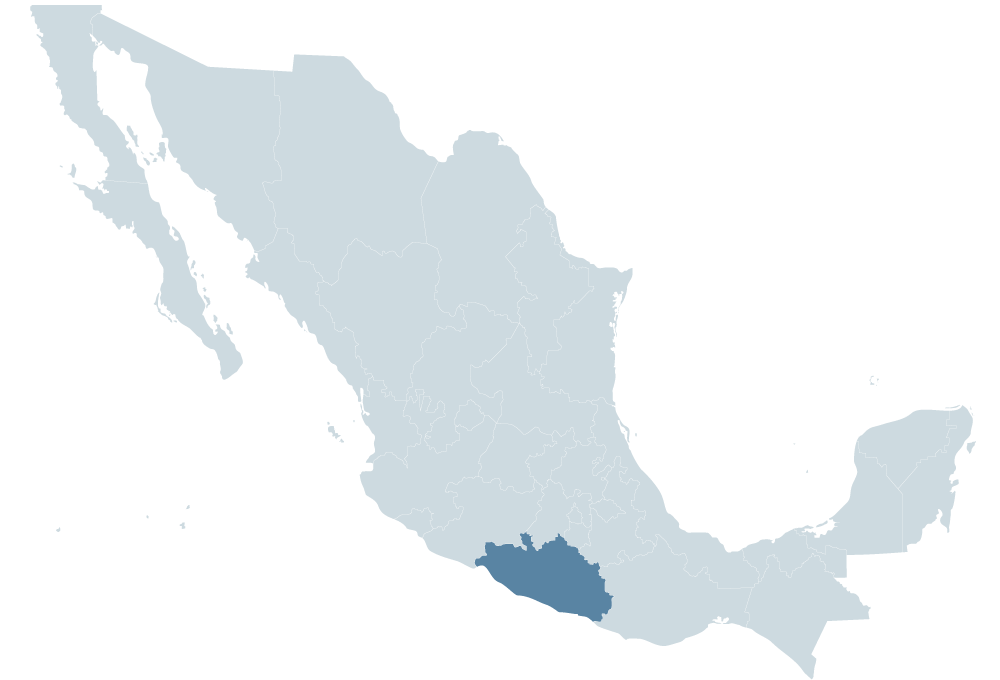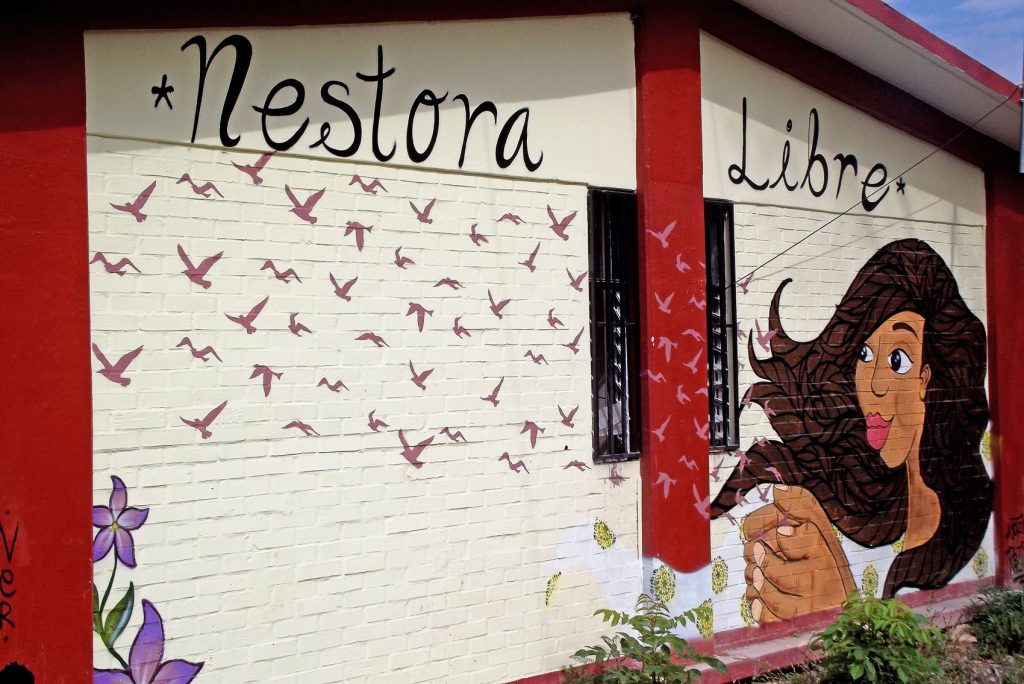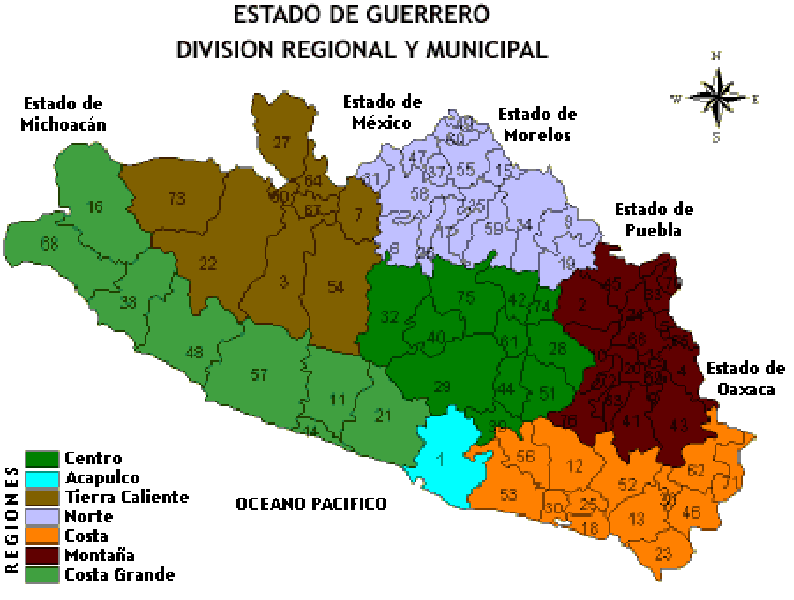We need your support. Your contribution makes it possible for SIPAZ to continue offering international accompaniment in the regions of Chiapas, Oaxaca and Guerrero.

Facts about Guerrero
Location :
Guerrero borders the states of Michoacán, México, Morelos and Puebla to the north; to the east, it borders Puebla and Oaxaca; to the south, Oaxaca and the Pacific Ocean; and to the west, the Pacific Ocean and Michoacán.
Guerrero has a surface area of 64,282 km2, which represents 3.3% of the country’s total area.

of the country’s total area
Regions and Municipalities :
Indigenous Peoples :
of the inhabitants of the Federation
of the population consider themselves indigenous
At the time of the conquest there were a little more than 20 original peoples, some of which were exterminated, decimated or assimilated, such as the Teco, Chontal, Tuxteco, Tepuzteco, Tlacotepehua, Mazateco, Huehueteco, Uautzapoteca, Tolimeca, Panteca, Chumbio, Apaneca, Cuyutumateco, Itzuco, Texime, Matlame, Texcateca, Tlatzihuizteca, Tepetixteca, Ayacasteco, Matlatzinca, Tisteco, among others. At the beginning of the 20th century, mention is made of seven of them: Nahuatl, Mixtec, Tlapaneco, Amuzgo, Popoloca, Purepecha and Cuitlateco. The last three disappeared, leaving until now the first four described for their population importance.
At present, the state of Guerrero has 3,533,251 inhabitants, which represents 3% of the inhabitants of the Federation. 1,198,478 inhabitants (33.9%) of the population consider themselves indigenous. Of the total population registered, 541,294 (15.3%) of people aged three years and over speak an indigenous language: they speak Nahuatl (35.6%), Mixtec (Tu’un Savi) (29.2%), Tlapaneco (Me’phaa) (17 , 8%), Amuzgo (ñomndaa) (6.7%). Of those, 125,796 people (23.24%) do not speak Spanish. The indigenous population is essentially found in the area of La Montaña and to a lesser extent in the Costa Chica, these being the most marginalized areas of the state. In the municipality of Acapulco, almost 165 thousand people consider themselves indigenous, while more than 50 thousand do so in Chilpancingo.
The indigenous population is divided into four groups:
256,504 nahualts (nauas), that is, approximately 21% of the indigenous population 21%
190,940 mixtecos (na savi), that is, 16% of the indigenous population16%
161,680 tlapanecos (me´phaa), that is, approximately 14% of the indigenous population14%
61,386 amuzgos (suljaa´), that is, 5% of the indigenous population5%
In Guerrero 6.5% of the population is considered Afro-descendant.
(INEGI 2015, SIC 2019, CDI 2015, INPI 2015)
High Level of Marginalization:
Guerrero ranks first in the degree of marginalization at the national level, followed by Chiapas and Oaxaca. Of the 81 municipalities in Guerrero, 36 of them are classified in the category of very high marginalization while 33 face situations of high marginalization.
% of the population lives in poverty
% of the population lives in extreme poverty
% of the population is vulnerable due to income
% is vulnerable population due to social deprivation *
* Social deprivation: educational backwardness, access to health services, access to social security, access to food, quality and space of the experience and access to basic services in living.
% of the population can be considered not poor and not vulnerable
(Coneval 2018, CONAPO 2015)
People belonging to the indigenous population have the highest level of poverty compared to other sectors of the population in a vulnerable situation. In predominantly indigenous municipalities there is a higher percentage of people living in poverty. Guerrero is one of the states in which indigenous municipalities present the highest percentages of poverty, 88.2%, and extreme poverty, 50.5%.
(CDI, 2016, SEDESOL 2015)
Income :
of people aged 15 and over
make up the economically active population in the state
62% of them are men and 38% are women
of them work in commerce and services
in agriculture, animal husbandry and exploitation, forestry, fishing and hunting
in industry
More than half of the households (52%) receive monetary income from government programs, the second highest percentage in the country after Chiapas, and 9.4% of households receive monetary income from transfers from another country.
It is worth mentioning that Guerrero, along with Michoacan and Jalisco, is one of the states of the Federation that receives the most remittances. According to the Bank of Mexico, Michoacan, Guanajuato, the state of Mexico, Guerrero, Oaxaca, Puebla, Jalisco and Mexico City received 53.9% of remittances in 2019, Guerrero receiving 4.8%.
(INEGI 2015, Coneval 2018 Banxico, 2020)
Right to Decent Housing :
total number of private dwellings inhabited in Guerrero
with an average of
occupants per dwelling
have electricity service
maintain a dirt floor
have a concrete or firm floor
have a refrigerator
have a car
(INEGI 2015)
Education :
In Guerrero, for many people, especially indigenous people, and even more so, women, the right to education is not fulfilled for various reasons. The situation of poverty forces children to work to improve the family economy. Furthermore, many isolated communities do not have the adequate infrastructure to facilitate education (lack of classrooms, furniture, books, basic services, lack of teachers, overcrowded classes…).
have basic education
higher
upper average
do not have schooling
Guerrero, along with Oaxaca and Chiapas, are the states with the lowest average schooling for people aged 15 and over. In Guerrero, it is estimated that the average number of years of schooling is 7.7, which is equivalent to a second year of high school (at the national level, it is 9.1).
In Guerrero, 13.6% of people aged 15 and over cannot read or write (15.8% for women and 11.1% for men). The level of illiteracy at the national level is 6%.
(INEGI 2015)
Tecnologías de la información
of the people of Guerrero have a computer and an internet connection
have a cell phone
have a television
(INEGI 2015)
Health :
- 85% of the people of Guerrero are affiliated with some type of health service: 77% are affiliated with Seguro Popular and 14% with IMSS. 65% go to health centers and hospitals of the Ministry of Health and 11% to the IMSS.
- The average life span is 73.2 years, the lowest in the entire country.
- In Guerrero, there are 1.1 general practitioners and specialists for every thousand inhabitants, the state with the second lowest medical coverage after Zacatecas.
- In Guerrero, the infant mortality rate is 9.7 per thousand live births.
- 7% of people 20 years of age or older suffer from obesity.
The “Index of the Rights of the Mexican Childhood”, which aims to determine the degree of fulfillment of the rights of girls, boys and adolescents in the national territory and in each of the federative entities, indicates Guerrero as the state with the second lowest score (0.37) on a 0-1 scale, just above the last, Chiapas with 0.36 score.
- Guerrero is the state in the country with the second highest maternal mortality rate, due to the fact that for every 100,000 registered births, there are 73.2 deaths, after Chiapas with 73.7.
- The average number of children per woman is 2.6, the third highest fertility rate in the country.
(INEGI 2015,2017,2018,2019, IDNM, 2016)
Land :
The state has an area of 63,596 km2, representing 3.2% of the national territory and ranking 14th in the list of states in the country. 40.9% of the surface is covered by natural vegetation; mainly forest, grassland, and jungle, while the remaining 59.1% is land used for agriculture and urban areas. 82% of its territory has a warm sub-humid climate. 58% of the people live in urban areas and 42% in rural areas.
(INEGI 2015)
Earth: A Clash of Visions
The concept of land is different according to indigenous peoples and the mestizo population. The indigenous peoples continue to consider the land as something integral (Mother Earth), sacred and collective, which cannot be sold. The ejidal and communal land property regimes have predominated in Mexico:
EJIDOS
each ejidatario receives a plot of land, and any decision that has to do with the lands of this nucleus must be made in the assembly of ejidatarios as a whole
COMMUNAL LANDS
the land belongs to all the members of a community, and consequently, the benefits of the community are distributed among all
Much of the land in Guerrero is under the communal and ejido regimes. In 2007, 1,514,459 hectares were ejidal lands (44.6%) and 417,445 hectares were communal lands (12.3%). The indigenous vision of the land is clashing with another mercantilist vision: the land has been reduced by the current economic system to its merely material dimension and has been fragmented at different times under the protection of the law. The concept of private property emerged, and hence many agrarian problems.
(State Agenda for the Development and Autonomy of the Indigenous Peoples of Guerrero, Tla-chinollan A.C. May 2005)
Land law: fragmentation and privatization
The collective ownership of land has been attacked many times in Mexican history. At the end of the War of Independence, in 1856, the confiscation laws prohibited communal property, ordered the division of communal lands, and the issuance of private property titles was authorized. Thus, in the Costa Chica and Montaña regions, the best lands were taken over by landowners who bought supposed property titles from local caciques, without taking into account the community members.
Although indigenous peoples managed to recover part of their lands after the Mexican Revolution, the constitutional reform of Article 27 in 1992 allowed a new opening towards their privatization of the lands. From this reform, PROCEDE (Program for the Certification of Ejido Rights) and PROCECOM (Program for the Certification of Communal Rights) were born. However, many civil organizations have denounced PROCEDE and PROCECOM for the divisions it has generated in the communities and in the ejidos, and for promoting the grabbing and sale of collective lands.
(YORAIL MAYA 4, June 2002)
Agrarian Conflicts
In August 2018, the delegate of the Agrarian Attorney’s Office (PA) in Guerrero, Jesus Francisco Corral Palomera, confirmed that 51 agrarian conflicts persist in the state. The state already has a high rate of deaths, wounded, displaced and imprisoned, due to agrarian conflicts, some of them lasting several generations.

Agrarian conflicts arise:
- Due to lack of land;
- Due to ambiguities and legal voids regarding agrarian rights and titles for decades and even centuries;
- Due to overlapping plans resulting from the delivery of documents altered by the agrarian authorities;
- Over disagreements about territorial limits;
- Over the hoarding and illegal occupations of ranchers and loggers that have the protection and support of the authorities;
- Due to inadequate or negligent responses from the authorities in the resolution of said conflicts.
The "hot spots" include, for example, the municipalities of Tepecoacuilco and Martir de Cuilapan, and the municipality of Zirandaro, in the Tierra Caliente Region, where the communities of San Pedro and Garzas are in dispute over 2,500 hectares of land with the inhabitants of Puerto Grande. The agrarian nuclei of Huitzapula and San Juan Bautista Coapla of the Atlixtac municipality, or clashes on the limits of Oaxaca and Guerrero (Cos-ta Chica) where inhabitants of Jicaral de Tovar (Oaxaca) and those of Jicayan (Guerrero) fight for their lands. Another problem remains in Marquelia, where a problem of three groups persists due to the dispute over 300 hectares of land.
(Government of Guerrero 2018, Tlachinollan 2019)

